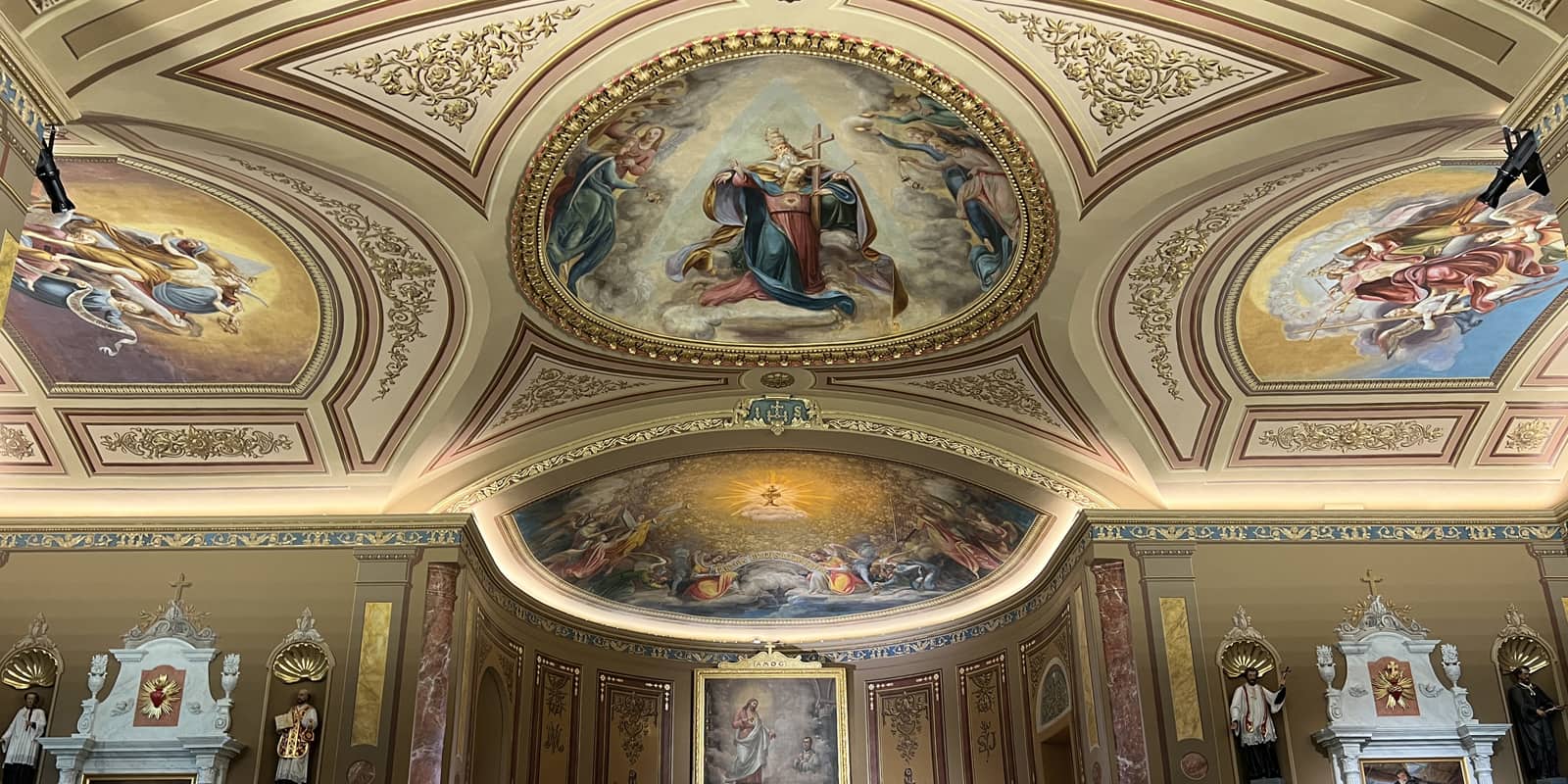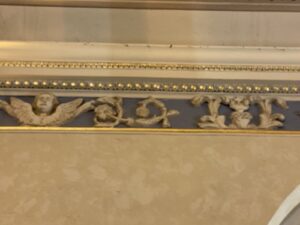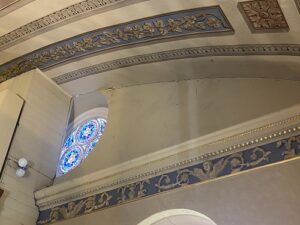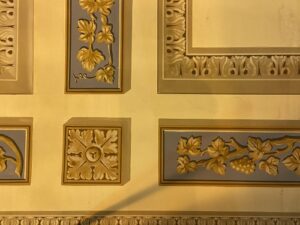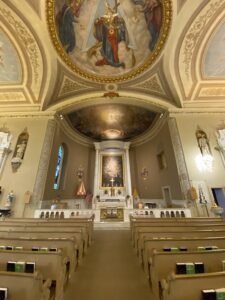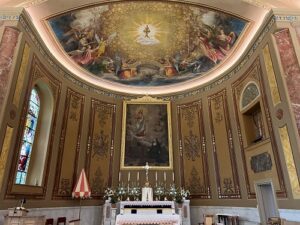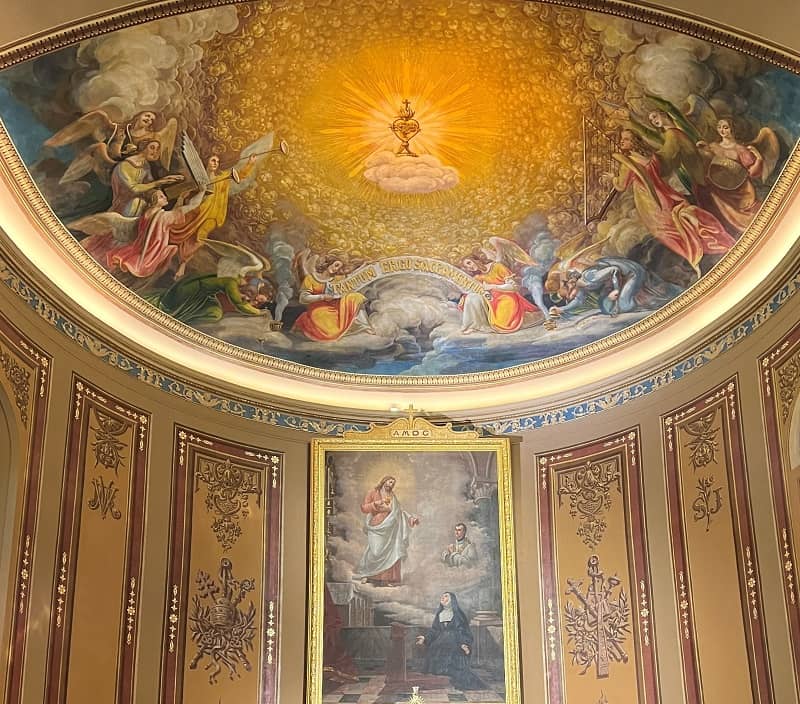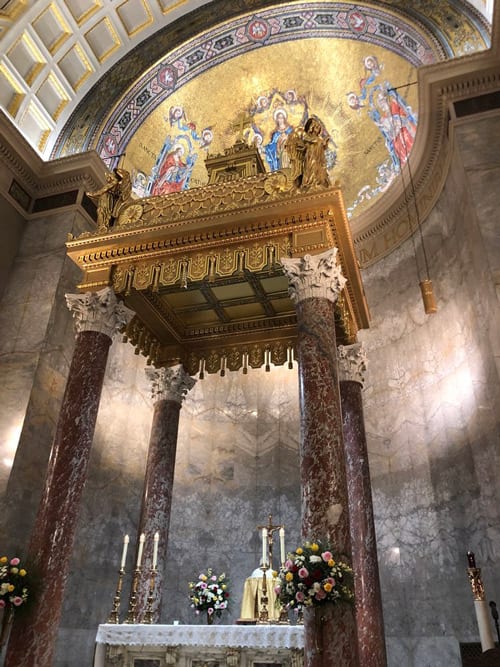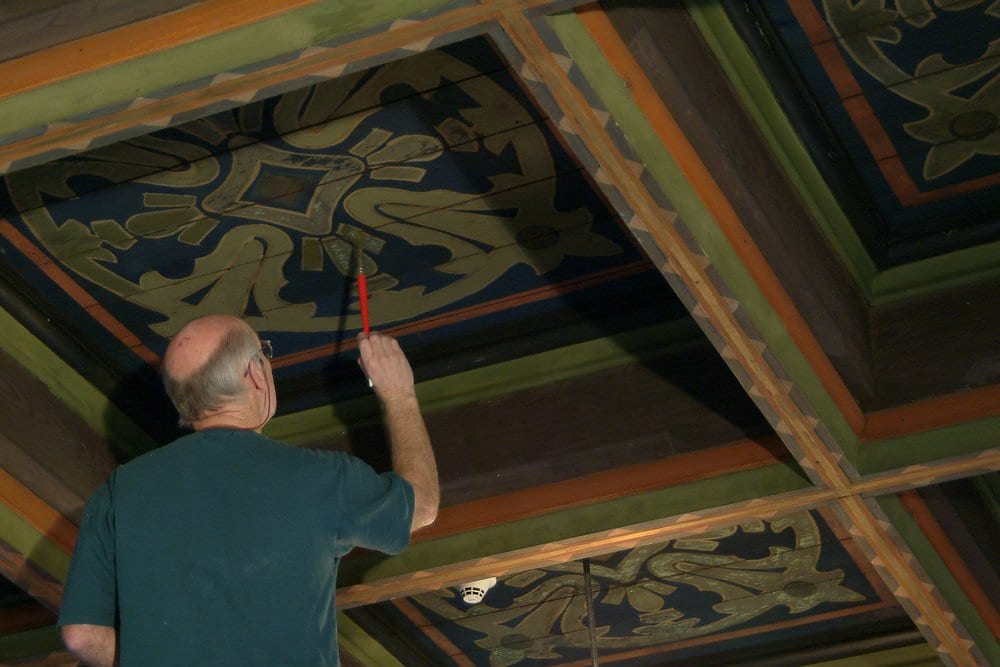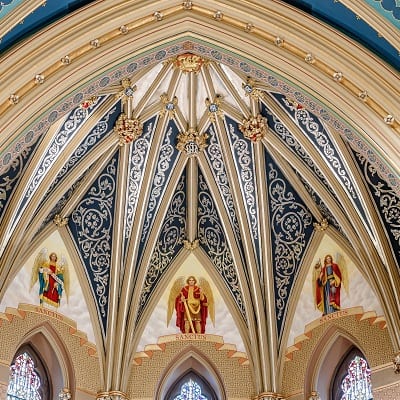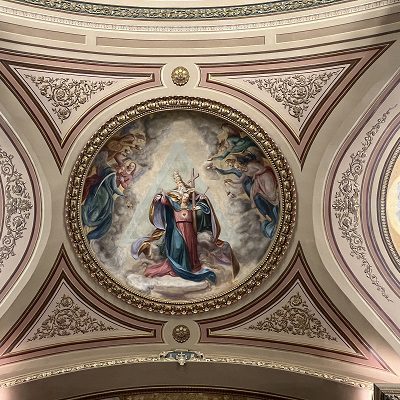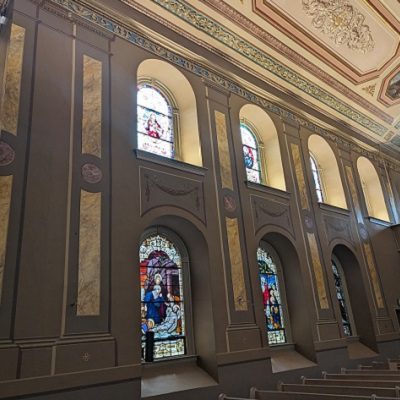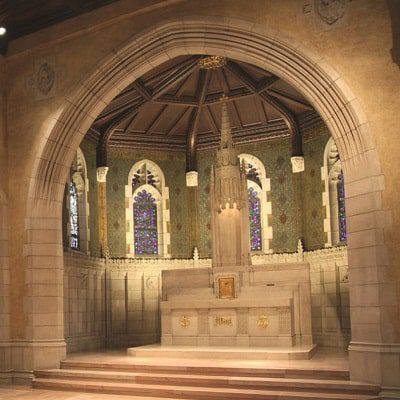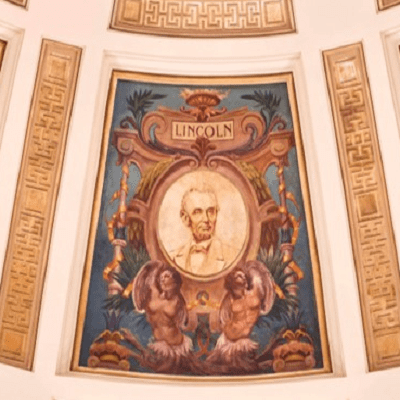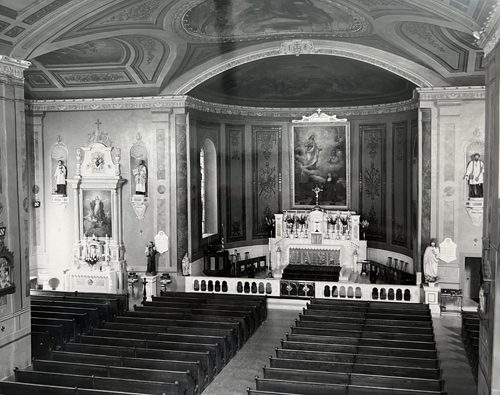
“Watch the old building with anxious care. Guard it as best you may…. Count its stones as you would jewels of a crown…. And do this tenderly, and reverently, and continually, and many a generation will still be born and pass away beneath its shadow.” John T. Reily
The Church – now Basilica – of the Sacred Heart of Jesus in Hanover, PA is at the center of John T. Reily’s Conewago: A Collection of Catholic Local History (1885). The locus of the Jesuit missions to Maryland and Virginia, and from Philadelphia to the frontiers of Pennsylvania, the church was built in 1787 and enlarged in 1850-51. On a hill surrounded by hundreds of acres of farmland, it rises, a restrained, red-stone structure, designed in the Federalist style of its time. Within its doors, however, the interior is a complete, immersive world of Baroque-revival decoration, visually hearkening back to the great 17th-century churches of Rome and their painted programs that proclaim a Church Triumphant. For Reily, the Church of the Sacred Heart is emblematic of the heroic nobility of the Catholic heritage of the Conewago Valley, and he concludes his history of the building with the fervent appeal quoted above to protect it for future generations. Canning Liturgical Arts took up Reily’s call, and now in 2023 has conserved and restored Sacred Heart’s artistic legacy for the future of Catholic Conewago and beyond.
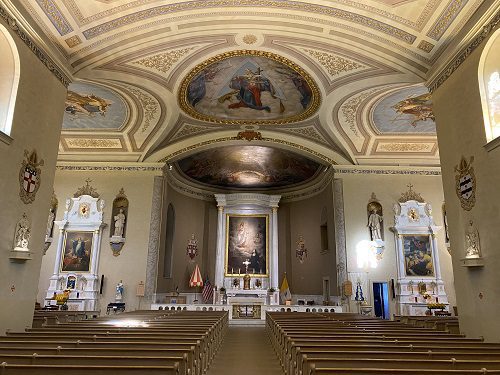
This photo was taken just before Canning began its work in fall of 2022.
Over the course of three key commissions in 1844, 1850, and 1887, the interior of Sacred Heart was organized visually and theologically into a grand, unified decorative program. Since the late 19th century, however, water and other surface damage as well as changes in artistic taste and fashion prompted interventions and overpainting that largely disrupted or effectively concealed the original painted scheme. In revealing and restoring the 19th-century program, Canning Liturgical Arts has recovered the experience intended by the original artists and priestly patrons.
That experience begins as soon as one passes through the reserved Federalist exterior and is drawn into the Baroque-revival jewel box of color and light, gilding and grandeur. Rising from the cruciform ground plan, a temple-like interior is created by architectural illusionistic paintings. Based on the 1887 decorative scheme created by the Italian artist Lorenzo C. Scattaglia, on either side of the nave, imposing tromp l’oeil pilasters appear to project from the walls. Decorated with richly veined and colored faux marbles, the colossal pilasters span two stories and divide arched stained-glass windows. Tromp l’oeil relief panels adorned with classical garland swags punctuate the space between the upper and lower windows. Seemingly supported by the pilasters, a cornice frieze runs the perimeter of the church interior. It is decorated by a repeating pattern of gilded plaster relief images of the sacred heart and winged cherub heads on a ground of Wedgwood blue. Above, the ceiling is like a crown to the nave. Elongated panels of gilded foliage on a blue-gray ground frame monumental illusionistic octagonal coffers, which are in turn decorated by intricately woven floral centerpieces. The totality of this architectural decoration impresses on the viewer feelings of surprise, delight, and awe.
The magnificence of the illusionistic structure of the nave then prepares one for the figurative drama at the ceiling’s center: the Assumption of Mary by Gebhart of Philadelphia (1844). A tromp l’oeil gilded ornamental frame acts as an enormous window opening to the vision of Mary rising heavenward. Clouds part in the otherwise clear blue sky to reveal a mandorla of golden light into which the Mother of God is enveloped. Supported by four winged angels, she appears weightless in her ascent as the classical garments swirl about the figures caught by the winds of the upper atmosphere. With her arms outstretched and her gaze focused upward, Mary leaves her earthly life in triumphal fashion. In the corners of the nave ceiling, four smaller octagonal “windows” to the heavens frame portraits of the Gospel writers, witnesses to the dramatic scene at center.
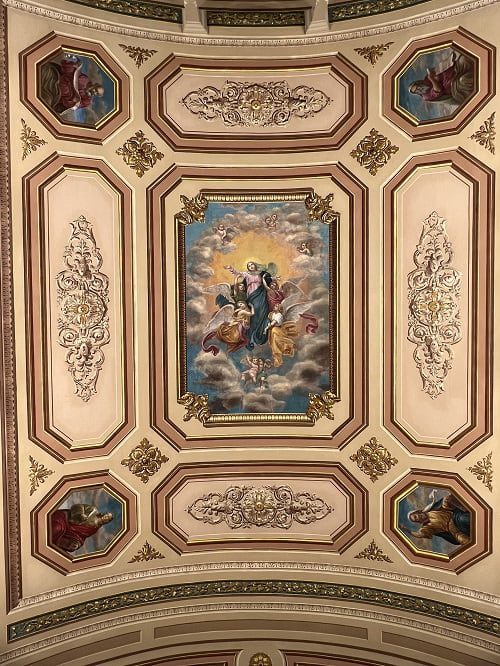
Moving closer to the sanctuary, the decorative program shifts from a Marian theme to a Christological one. Franz Stecher, the artist employed in 1850 to paint the newly constructed transept and apse, created a Life of Christ series that unifies the walls and ceiling. Now seen embedded in the scheme of monumental illusionistic architectural paintings created in 1887 by Scattaglia, Stecher’s program begins in the barrel vault of the north transept with a painting of the Trinity in heaven seen moments before the Incarnation. Floating in a golden light and resting on a white triangle, symbol of the Trinity, God the Father cradles his Son in his lap, their faces nestled together and embraced by the white dove of the Holy Spirit. The nude adult body of Christ, wrapped in swaddling clothes, sinks heavily into the Father, his sinuous musculature and elongated limbs reminiscent of Florentine Mannerism of the 16th century. In his right hand his delicate fingers hold the golden crown of glory taken from his head while his left reaches for the wooden cross and crown of thorns held out to him by the Father. Two angels hover below, displaying a ribbon inscribed: “Drop dew ye heavens from above and let the clouds rain the just – Is 45:8.”
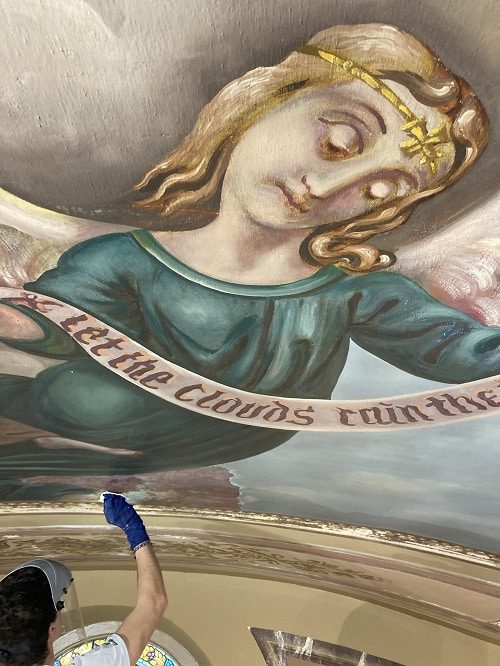
Here our conservator is removing layers of paint that have been built up over the years.
Stecher’s program resumes on the south transept wall with the Crucifixion. Mirroring the tromp l’oeil frame and stylistic classicism of the Nativity, the Crucifixion is as physically motionless and emotionally restrained as any early 15th-century Florentine rendition of the subject. The figure of Christ on the cross rises, statue-like against the darkening sky, a barren desert landscape receding into the distance. At the foreground, Mary and John the Evangelist (below) stand in solemn mourning while Mary Magdalene kneels at the foot of the Cross, her golden hair streaming down over her shoulder. Hugging the cross, she picks up a length of the cloth folded neatly on the ground in preparation for Christ’s burial. A small footed vessel, presumably holding the spices to be used at the entombment, stands nearby.
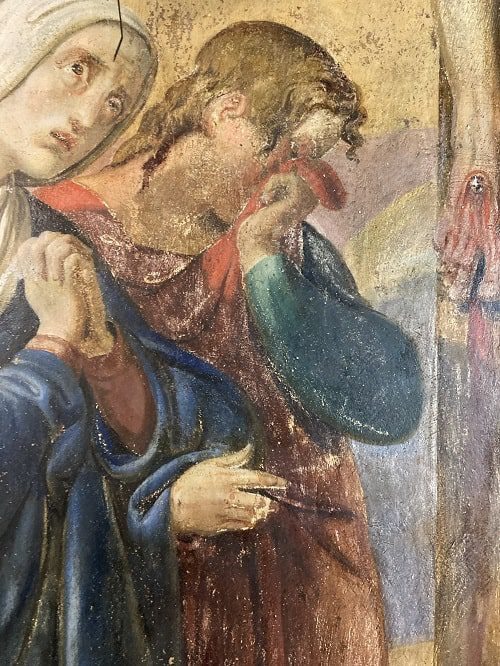
Our conservators removed years of overpainting to reveal Stecher’s original paint scheme.
The verse from Isaiah, which continues “let the earth be opened and bud forth a savior,” finds its visual manifestation in the wall painting below the Nativity. Flanked by stained glass, the restored tromp l’oeil lunette frame encloses the image of Mary (below) and Joseph kneeling beside the infant Christ in the manger. Unlike the exaggerated elegance of the figures in the heavenly scene above, Stecher employs a more classical style to this earthly scene. Serpentine Mannerism is exchanged for quiet and controlled gestures. Behind the Holy Family, the ox and ass look on and the night sky of Bethlehem is seen through the rough timbers of the stable. A haloed angel floats above, unfurling a banner that reads: “Gloria in Excelsis Deo.”
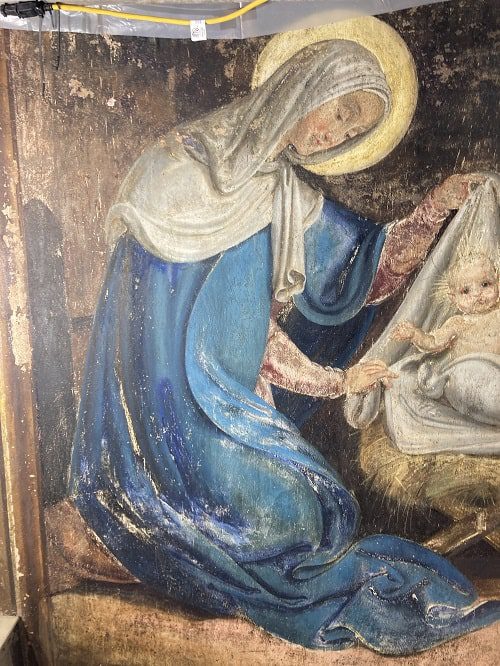
In this image taken during the conservation process, the painting was cleaned and repaired followed by inpainting to bring back Stecher’s original vision of the Nativity.
In the barrel vault above this somber scene, Stecher returns to a more expressive Mannerist style as he envisions Christ returning to the bosom of God the Father. Christ rises up into the heavens, his body wrapped in the swirling drapery of martyr’s red but exposed just enough to exhibit the wounds of the Cross. As he approaches the Father, he twists, not in the agony of the Cross, but to bring his face in a loving caress with that of the Father and with the dove of the Holy Spirit. Two angels rise up from below, on the left holding the wood of the Cross and on the right holding a banner heralding the Resurrection with “Alleluia” emblazoned upon it. Christ’s crown floats on a cloud beside him while God the Father now dons the tiara and holds a scepter surmounted by a cross, symbols of kingship and dominion. Gold letters rise out of the clouds that surround the scene, reading: “SEDE A DEXTRIS MEIS” (“sit thou at my right hand”).
This fresco a secco ( oil paint on dry plaster) required repair and restoration of original artwork and color scheme.
Stecher’s Christological program culminates in the enormous circular scene above the church crossing, crowned with an ornate gilded plaster frame. The image of God the Father sits atop a throne of clouds before a triangle of light. The tiara is upon his head and the scepter in his left hand. Before him stands Christ now fully clothed in his royal garments and sheltered under the spreading wings of the Holy Spirit. The Cross rests in his left arm and the end of the scepter held by the Father is cradled in his fingers. With his right hand raised in benediction, he parts his robes to reveal the Sacred Heart surrounded by golden light on his chest, symbol of the triumph of Divine love. This scene of glory is framed on either side by three graceful angels who raise censers in their delicate hands, the perfumed smoke billowing heavenward.
The final major component of the Basilica of the Sacred Heart’s decorative program is located in the apse. Due to significant water damage, the rear wall of the sanctuary was renovated in 1887 and all previous decoration was replaced by Scattaglia. Continuing the grand architectural statement created in the nave, on the curved back wall of the apse (below) Scattaglia painted tromp l’oeil panels, framed in red, ornamented with gold patterns, and decorated with intricate centerpieces of the insignia and regalia of the Church. Behind the altar, a painting of the Vision of the Sacred Heart to St Margaret Mary by Filippo Costaggini of Rome was installed. Here the saint clothed in her religious habit kneels before the Sacred Heart of Jesus descending to her surrounded by clouds. In the background, hovers her spiritual director, Blessed Claude de la Columbine.
On the left, the sanctuary with the apse ceiling before Canning began work, and on the right, we are finishing the work on the ceiling.
Below, the finished apse ceiling brings Stecher’s work back to life.
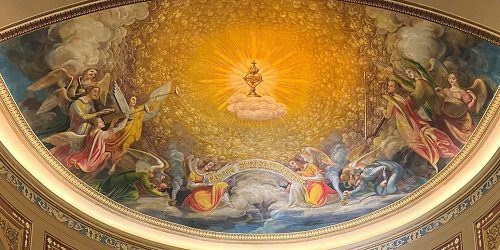
Above, however, in the semi-dome remains the Adoration of the Blessed Sacrament painted by Stecher in 1850. At the center a golden chalice in the shape of the Sacred Heart rests upon a cloud as rays of light stream forth from it, illuminating the heavens teaming with the faces of cherubim. At the foreground, a small symphony of angels plays trumpets, an organ, and a harp while others kneel, opening censers from which smoke rises and mingles with the heavenly host above. At the very center two angels hold an arched banner with the words: “TANTUM ERGO SACRAMENTUM” (“so great a sacrament”), the words sung at Adoration and Benediction. This glorious conflation of the Sacred Heart and the Blessed Sacrament, soars above the sanctuary, filling the entire semi-dome and creating the illusion that the heavens have broken through to the church interior directly above the altar of consecration. Framing this climax of the church’s decoration, Scattaglia created a triumphal arch in the grandest classical style. Faux veined marble columns of colossal dimensions stand at either side of the apse and appear to support the cornice frieze and the arch that outlines the semi-dome. Facing the nave, this arch is adorned with gilded vines on either side of the monogram “IHS,” the seal of the Society of Jesus, a crowning reminder of the patrons of this great 19th-century decorative program.
Now that Canning has restored the Sacred Heart to the height of its artistic glory and of its theological integrity, it begs to be studied in greater depth. In the coming months, we look forward to exploring two key questions raised by this visual summary of the church interior: (1) how does this decorative program fit within the history of Jesuit church decoration, most especially that of 17th-century Rome; and (2) in what ways does this painted program, including both figurative murals and architectural illusionistic painting, proclaim a Church Triumphant that reaches down to touch the humble fields of southern Pennsylvania? In giving the Basilica this ongoing academic attention, we hope to show that historic conservation and preservation makes an impact much deeper than what is seen on the surface.

–More to come on the architecture of the Basilica of the Sacred Heart-
Written By Amy Marie Zucca, Ph.D.

Amy Zucca is the resident art historian for John Canning & Co. and Canning Liturgical Arts. With a doctorate in art history and a specialization in the Italian Renaissance, Amy brings historic insight to our projects, new art commissions and design work for the company. If you have a painting you’d like to have evaluated for its historic significance or are interested in commissioning artwork for your sacred space, please contact Amy directly at amy@johncanningco.com.

